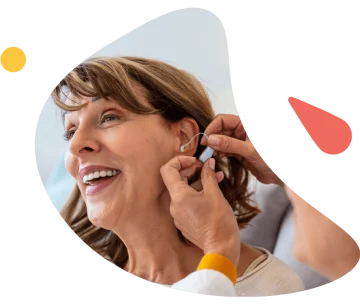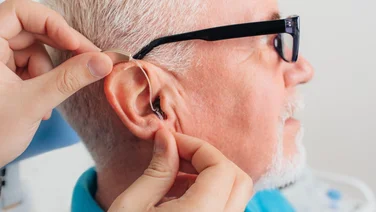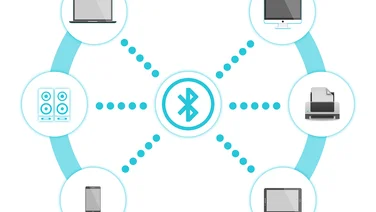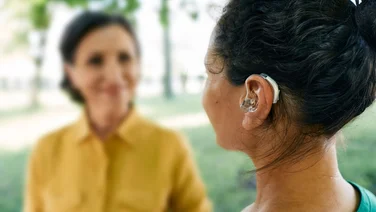As hearing aids can be an expensive purchase, you’ll want to protect yourself against unnecessary spending by prolonging the lifespan of your hearing aids. The simplest way to keep them in the best condition is to clean them regularly.
Can you clean hearing aids?
The short answer is ‘yes’ – but do so with care. Many hearing aids are quite robust, but the fact remains that they are tiny, delicate electronic devices and should be handled as such.
With the right tools and by following the correct guidance, keeping your hearing aids clean is an easy and straightforward task.
Your audiologist or provider may show you how to clean your hearing aids when you have them fitted. The manufacturer of your hearing aids might also provide specific cleaning instructions for your chosen model.
Need a hearing aid appointment?
We can set you up with a local audiologist for free advice
Why do I need to clean my hearing aids?
Maintaining your hearing aids as well as you can will help you to avoid extra costs of professional maintenance or replacement.
The ear canal, where part of your hearing aid sits, is prone to moisture and the build-up of wax and dirt. This moisture and debris can get into the delicate components of your hearing aid. Over time, it can stop the hearing aid from working as it should, and you might notice your hearing worsen.
Prevention is better than cure, so regular cleaning can stave off these problems.

What can I use to clean my hearing aids?
Many hearing aids come with special tools you can use to clean their different parts.
In addition to a wiping cloth, you may also receive a small pick or wire and a brush, which will be used to remove wax and debris from the surface of the hearing aid. Some also provide special wet wipes or a cleaning/sanitizing solution, and a receptacle for drying the hearing aids.
You can also buy hearing aid cleaning kits from most high street providers and online retailers at a small cost. If you prefer, you can use a soft-bristled toothbrush.
Don’t be tempted to use any chemicals, wipes, detergents, or alcohol on the electronic parts of your hearing aid – the microphone, speaker, or amplifier – unless they are specifically made for that purpose. The ingredients in other products may cause damage.
Special hearing aid dryers are available as accessories for some hearing aid brands and models. These can be used to dry your hearing aids after cleaning.
How do I clean my hearing aids?
One of the key points to bear in mind is not to avoid force or scraping when cleaning your hearing aids. If you clean them regularly enough, you shouldn’t need to – a gentle technique should be sufficient.
Secondly, make sure you always wash and thoroughly dry your hands before and after cleaning hearing aids.
There are two main types of hearing aids: behind the ear and in the ear.
Behind-the-ear (BTE) hearing aids
With this type of hearing aid, the electronic elements are contained in a plastic casing that hooks over the top of your ear and sits behind it.
The case is attached to thin tubing, which attaches at the other end to an earmold or domed tip that sits in the entrance to your ear canal.
In-the-ear (ITE) hearing aids
With this type of hearing aid, there is no external casing that hooks around the top of your ear. Instead, all of the components of the hearing aid sit in a shell in the bowl of your ear, or sit deeper inside your ear canal.

How to clean a behind-the-ear (BTE) hearing aid
- Check if there is any visible wax or dirt on the casing or the earmold/domed tip, and gently remove it with a cleaning brush or a dry wipe or cloth.
- Remove the earmold or domed tip from the casing. The case shouldn’t need too much cleaning other than a brief wipe, because it doesn’t come into direct contact with the moisture and wax inside your ear.
- Set aside the casing and store it as per the manufacturer’s guidance.
- The earmold or dome can be cleaned more thoroughly, using warm water with a drop of dish soap to remove any staining or build-up of wax and dirt.
- You can run water through the tubing to make sure there are no wax or dirt particles blocking it. If it’s blocked, insert your pick or wire tool into the tubing at either end to push the blockage out. Don’t push too hard or force the tool.
- Leave the tubing and the earmold/tip to dry thoroughly before reattaching the casing (overnight is best).
- You can use a bulb blower to push air through and direct droplets of moisture out of the tubing. Or, if you have one, place your devices in your hearing aid dryer. Don’t use a hairdryer to dry your hearing aids.
How to clean an in-the-ear (ITE) hearing aid
- Use a hearing aid cleaning brush or a soft-bristled toothbrush to clear away any dirt or wax from the surface of your hearing aids.
- When brushing the microphone port, receiver, and vent holes, do so gently. Hold your hearing aid with the opening you are cleaning facing downwards so loose particles fall out of and away from the hearing aid, rather than getting stuck inside.
- If any debris is left after using the brush, use the pick or wire to remove it from the holes. Take care not to push wax or dirt further into the holes.
- Don’t use the pick in the filter opening, as it could pierce it.
- Wipe your hearing aid with a tissue or a clean, dry wiping cloth.
How often should I clean my hearing aids?
It’s usually advised to take your hearing aids out at night and, if you have rechargeable hearing aids, you should charge them at night while you’re asleep.
This is a good opportunity to do some basic, daily maintenance. Before you store or recharge your hearing aids, give them a quick wipe over with a dry tissue or wiping cloth. Doing so every day can prevent them from accumulating dirt and wax.
In addition, give your hearing aids a thorough clean once a week to keep them in good condition and functioning well.
Any time you experience difficulties with your hearing aids – if you’re struggling to hear as clearly as you normally would, for example – try giving them a good clean to troubleshoot what the problem might be.
As well as at-home cleaning and maintenance, it’s a good idea to have your hearing aids checked regularly by your audiologist or provider. If your hearing aids have become clogged with dirt or wax, your provider can get provide a deep clean using specialist suction tools.
Speak to a qualified hearing consultant
- Do a basic daily cleanse at the end of the day, before storing your hearing aids overnight.
- When you’re not using your hearing aids, keep them in a cool, dry environment (follow the guidance of the manufacturer or your audiologist).
- Avoid leaving your hearing aids in a very hot, cold, or wet environment, like a bathroom.
- Take your hearing aids out when you’re showering, bathing, or washing your hair or face.
- When using hair styling products, remove your hearing aids first and put them in when you’ve finished.
- If you often get a build-up of wax, you might benefit from using a wax guard or wax trap. Ask your provider or audiologist about this and, if the wax persists, you might need to have earwax removal treatment.
- If you notice your hearing aid is becoming stained or has an unpleasant smell, it could be a sign that you have an ear infection. Talk to your audiologist or doctor for advice.







